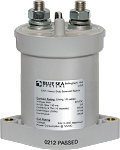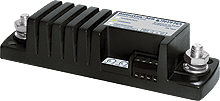 | In this issue: | • | Press Release
Blue Sea Systems New L-Series Solenoid Offers Superior Performance in Harsh Environments | • | Application Briefs
Three Practical Applications for the CL-Series BatteryLinkTM ACR: Load Shedding, Pilot House Navigation Battery Isolation, Charge Current Limiting | | • | Technical Brief
Choosing Circuit Protection | | • | Update
Blue Sea Systems’ Engineering Contributes to ABYC Standards Revisions
|
| MAATS 2006 Show
July 19-21
Las Vegas, NV

Make your travel plans for MAATS (Marine Aftermarket Accessories Trade Show). It will be at Caesar's Palace in Las Vegas, July 19-21. Look for the Blue Sea Systems booth 643. For more information about MAATS, click here.
Blue Sea Systems Circuit Solutions Newsletter Archives

Issue 25
(April 17, 2006)
Press Release:
300A ANL and SEA Fuse BlocksApplication Brief:
600 Ampere Busbar Negative Tie Point Application Brief:
Supplying Power to Large Loads

Issue 24
(March 22, 2006)
Press Release:
150A Busbar Application Brief:
Improvements to 150A Busbars

Issue 23
(February 15, 2006)
Press Release:
WeatherDeck™ Water Resistant Circuit Breaker Panels Technical Brief:
IP (Ingress Protection) Ratings Application Brief:
WeatherDeck™ Water Resistant Circuit Breaker Panels Technical Brief:
Common Switching Applications

For a complete list of past Circuit Solutions issues, click here.
|
| Press Release
Blue Sea Systems' New L-Series Solenoid Offers Superior Performance in Harsh Environments

PN 5301/PN 5302 |
The L-Series Solenoid Switch is an excellent choice for remote battery switching. It saves the cost, weight, and difficulty of running long heavy battery cables. It’s a smart alternative to traditional battery switches. To learn more, click here (PDF file: 89KB).
Application Briefs
- Improving marine electrical systems with Blue Sea Systems products
Three practical applications for the CL-Series BatteryLink™ ACR

PN 7600 |
The CL-Series BatteryLink™ ACR is a current-limiting, voltage-sensing relay with adjustable combine and disconnect thresholds. It automatically combines battery banks during the charging cycle, and isolates battery banks when voltage drops below a certain level.
The CL-Series BatteryLink™ ACR also may be used for these practical applications:
Technical Brief
- Non-product-specific technical information for improving safety, reliability, and usefulness of marine electrical systems
Choosing Circuit Protection
You may want to rethink the process that you use to select circuit protection. It’s not as simple as referring to circuit protection standards tables. Blue Sea Systems' engineers identify new factors to consider when selecting circuit protection. Click for more information.
Update
Blue Sea Systems Engineering Contributes to ABYC Standards Revisions
Wayne Kelsoe, Blue Sea Systems Vice President, Research and Development is a member of ABYC technical committees working on two important areas of the Standards.
Battery Switch Standard
The battery switch standard is being revised to give boat manufacturers better guidance in selecting battery switches for engine starting circuits. The Blue Sea System's Engine Starting Standard (PDF file: 35KB), developed in 2001, is being modified to replace or revise UL1107 which ABYC uses as the reference for rating battery switches. The extreme high currents and short durations of engine starting stress were previously not tested in the UL Standard. Manufacturers have created their own tests and make various claims of capacity—some manufacturers rate for repeated pulses totaling approximately 100 seconds, some other manufacturers rate for only a single pulse of 10 seconds or less. Clearly, a commonly-agreed upon standard is needed.
High Current Faults
Also being revised is the standard for circuit breaker operability after an extremely high current fault. The commonly used UL1077 Standard recognizes some circuit breakers as being capable of repeated maximum fault current, and other circuit breakers as "failing safe" but not being reusable after interrupting maximum currents. The devices are not marked according to the outcome of these tests; the fault behavior can be determined only by examining the UL documents.
System design guidance is under consideration that can be used to predict high level faults. In some instances, present standards may be too strict; in other circumstances, even higher stresses may occur than are predicted in the ABYC E-11 Standard.
|
| |
You are receiving this newsletter from Blue Sea Systems because you have contacted us or subscribed on our website.
If you wish to unsubscribe, please send an E-mail to listmaster@bluesea.com with the word REMOVE as the subject.
If you’ve received this newsletter from a third party and you wish to subscribe to Blue Sea Systems' eNewsletter, please send an E-mail to listmaster@bluesea.com with the word SUBSCRIBE as the subject.
Blue Sea Systems would like to hear from you regarding any questions you may have, or any suggestions for publication in future editions of the Circuit Solutions™ Newsletter. Please send us your suggestions to: listmaster@bluesea.com.
Copyright ©2006 - Blue Sea Systems, Inc.
425 Sequoia Drive, Bellingham, WA 98226 USA
Phone: 360-738-8230
Fax: 360-734-4195
Website: www.bluesea.com |
|
|

